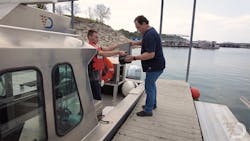Subsea Data Transfer Just Took a Giant Step Forward with Cloud-Based Solution
Humans have been exploring the seas for as long as we’ve been a species, yet still only 5% of the ocean has been precisely mapped and understood. One of the biggest difficulties ocean exploration and research teams often encounter is the complicated process to transfer enormous amounts of data from miles below the ocean surface. Usually, data is manually retrieved by sending a ship out to a Remotely Operated Vehicle (ROV) or Autonomous Underwater Vehicle (AUV), pulling out the hard drives, taking them back to shore, and manually transferring the data to a larger server. Companies and research organizations have suffered through this arduous and painstaking process, until now.
Lyve Mobile by Seagate is a ruggedized, high-capacity, and easily integrated solution that gives companies an expansive, in-depth understanding of the subsea environment by moving data from autonomous underwater vehicles to end-users—quickly and easily.
One of the first companies to utilize Lyve Mobile was Terradepth, an Austin, Texas-based business specializing in providing ocean data-as-a-service to oil and gas companies and other entities involved in the global telecom, clean energy, and national security industries. Terradepth provides customers with a variety of data sets including those for bathymetry (the measurement of the depth of water in oceans, seas, or lakes) and hydrography (the science of surveying and charting bodies of water, such as seas, lakes, and rivers), which helps with geospatial mapping and other actions.
The company’s goal is to become the ocean data repository for organizations to store data, market their data, and launch new products involving distinct types of ocean-based data for their own customers.
Terradepth achieves this by utilizing submersibles that operate in some of the most inhospitable spots on the planet, frequently in the most remote ocean depths. When creating its operation, one of the chief challenges the company faced was finding a secure way to transfer data from autonomous underwater vehicles to data centers, then to its customers. Seagate was able to deliver a reliable solution that would perform seamlessly in severe environments with its Lyve Mobile Array.
To create its desired “ocean data exchange,” Terradepth needed a reliable, sturdy, modern method of data transfer in the field. The data collection process typically involves using AUVs moving between semi-submerged and “at depth” operation modes. Meanwhile, when the AUVs are topside, they handle data collection at the sea surface, and when submerged, the vehicle conducts its surveying mission.
For smaller vessels that have little to no room for a human to get inside to connect to the equipment, there is a data port on the outside of the boat. The technician will use the data port to offload the data from the vessel and transport it to Terradepth’s “ingest” location. The storage device then goes back out to repeat the process. For larger vessels, some are able to connect directly to the server on board and offload data when the boat comes into port.
After they have offloaded the data with Lyve Mobile Array, the device is then transported to the data center where a Lyve Mobile Rackmount Receiver is set up.
Terradepth required a data transfer solution that was ruggedized enough for extreme environments, could easily connect to its AUVs, handle the high amount of data that its missions produce, and would easily connect back into its Austin data center for incorporation and immediate use within its Absolute Ocean platform.
“We were introduced to Lyve Mobile early, with an initial need for high-volume data collection,” explained Childress. “We have vehicles that will collect dozens of gigabytes of data in a very short period, with certain sensor suites that could collect many terabytes of data in just a few days. We now have a system, with Lyve Mobile, that operates out in the open ocean for extended lengths of time and offers high-volume capabilities. Lyve Mobile helped us eliminate the need for continuous human supervision during ocean data collection operations.”
As Childress mentioned, Seagate was able to deliver with the Lyve Mobile Array; a data transfer solution for Terradepth’s ocean data. Operators on land or on a surface vessel accumulated data from the AUVs which is retrieved at the end of a mission via a cable connection and is saved to 96-terabyte Lyve Mobile Arrays. The edge-collected data is then transferred in bulk, using a SAS high-speed interface into a Rackmount Receiver to Terradepth’s on-premises cloud access point, where it is then automatically processed and made viewable.
“Currently, most ocean geospatial data is saved locally and not utilized through the cloud,” said Childress. “The data is typically processed, viewed, shared, and generally used within organizations’ workflows via desktop-based software rather than through internet access. Terradepth is aiming to become an innovator by moving the experience of collecting, sharing, and cataloging ocean data from older, legacy, static mapping sites to something akin to today’s modern, dynamic, interactive online map applications. That type of mobility is just much more practical for us, considering the volumes of data involved. Being aligned with a company like Seagate and its experience makes it even more attractive.”
By 2024, Terradepth is planning for its AUV missions to employ a tandem vehicle deployment method where one vehicle is topside while the other is submerged, with both providing data to operators through Lyve Mobile to an upload to the cloud.
“For us, the faster we can get the data into our cloud environment as a service provider,” Childress said, “the faster we can deliver it visually and collaboratively.”

